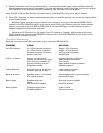Note: When numerous amplifiers are used in the same system, look into using a relay with a separate power
wire connected to an alternative power source to take the strain off the source unit. Normal source units can
only keep a constant 12 volts to 2 or possibly 3 amps. This wire should also be run on the away from the RCA
cables.
• CAP+: This 8 gauge terminal is internally wired in parallel with the +12V on the StreetWires Power
connector. It is the ideal connection point for the positive side of a capacitor to increase the amplifier’s
performance.
• CAP-: This 8 gauge terminal is internally wired in parallel with the GND on the StreetWires Power
connector. It is the ideal connection point for the negative side of the capacitor to increase the amplifier’s
performance.
Double check all the previous connection installation steps, in particular the speaker and power wiring.
Securely mount the amplifier. If everything is in order, reconnect the vehicle’s negative battery connection and
begin following the feature setup and adjustment steps.
Feature Setup and Adjustments
1. Selecting the Input Sensitivity Range – Before you turn on your system, you must select the proper input
sensitivity range on your amp using the button labeled INPUT SENS located in the GAIN CONTROL section of
the control panel.
• Setting for Aftermarket Source Units: Refer to your aftermarket owner’s manual for line level output
specification. If the specification is not available, please follow the instructions listed below.
X1 POSITION: 100mV–1V (Typically for RCA Input)
• Setting for Factory (OEM) Source Units: To check the amount of voltage that is present from the source
unit, take a multi meter, or a volt/ohm meter, on the AC setting, (range from 100mV up to 10 volts) attach the
positive and negative leads directly to any exposed speaker. It will not matter if the polarity is correct, it will
read the same amount of voltage.
X10 POSITION: 1V–10V (Typically for Speaker Level Input)
Note: It is important not to have the amp set up to receive a low voltage signal and give it a high voltage signal.
Doing this can cause damage to the amp.
2. Adjusting the Gain Control – Before you start setting your amp gains, be sure to defeat all EQs (“off” position).
You want to set the gain levels properly BEFORE applying any equalization.
Start with the source unit’s volume around ¾ of the way up, and the gain on the amp all the way down
(counter-clockwise). Slowly increase the gain clockwise until the speaker starts to distort. Immediately
decrease gain until the distortion goes away. This will be a good reference point on the volume control to
where the signal starts to distort. Remember every CD will be different; use common sense and constantly
listen for obvious distortion and adjust volume accordingly. The gain on the amp has nothing to do with how
much power the amp can produce, just how fast the amp puts out max power. Just like in an automobile, full
throttle is very rarely needed.
3. Adjusting the Low, 24dB @ 40Hz - 200Hz Variable Low Pass X-over Frequency Controls–
• Setting for Subwoofers: Using “L-PASS CROSSOVER” you have control over what frequency you want
your amp to start crossing over your signal. By turning this control all the way counter-clockwise you are
crossing the signal over at 40Hz (the range is counter-clockwise 40Hz to clockwise 200Hz). This means that
the amp will send the woofers frequencies from 20Hz to 40Hz and then start to taper down as the frequencies
go over 40Hz (24dB/octave roll off). The industry standard for low pass crossover point is right around 90Hz.
However by experimenting with the crossover point (higher or lower) you will find what sounds best in this
install. The decibel per octave roll off (dB/oct) means how fast the amplifier tapers down as the frequencies
get higher. This amp uses a 24-decibel per octave roll off, which is pretty steep, or tapers off fairly quickly from
the crossover point. This design complements both the subwoofer and the mid to provide greater musical
detail.
4. Adjusting The Variable ThunderEQ – Adjust the dial clockwise to add the desired amount of bass boost. Keep
in mind that there is a lot of boost available, 18dB of 40Hz, but begin with a low boost setting (around 3dB)
and try to stay below 6dB whenever possible. Remember that for every 3dB of additional boost you dial in,
you are asking the amplifier to double its power output for this boost region.







